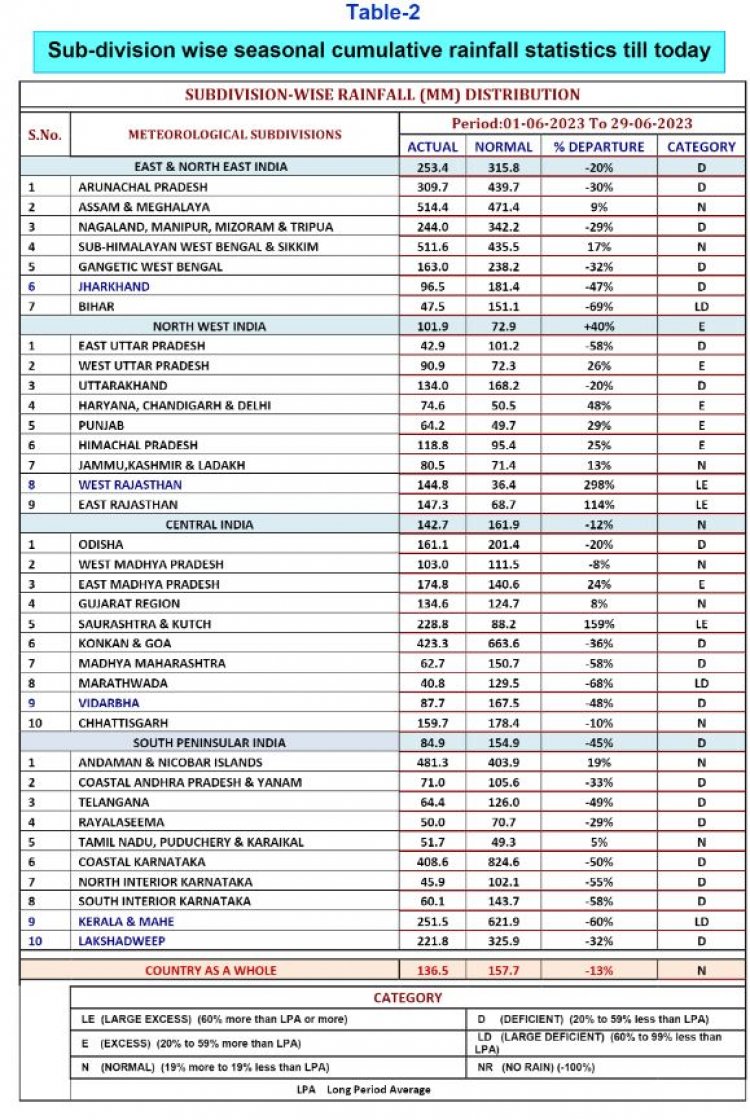Haphazard rainfall has delayed sowing of kharif crops such as paddy, maize and tur in many parts of the country, with 14 key agricultural states still 'deficient' in rainfall and two figuring in the 'large deficient' category, according to the India Meteorological Department (IMD). This could hit output of kharif crops as well as force farmers to shift to short-term crops, said industry executives and experts.
The impact of the indifference of monsoon is clearly visible on the sowing of major crops as the area under paddy sowing has decreased by 26 per cent. Though the total sowing area of pulses may have decreased by just 2 per cent, the maximum decrease has come in the sowing of pigeon pea. Arhar area has decreased by 79.44 per cent. Due to the increase in the area under groundnut, there has been an increase in the total area under oilseeds, but the area under soyabean has decreased by 17.23 per cent and the area under sunflower has decreased by 65.78 per cent. Sowing of kharif maize has decreased by 24.29 per cent and that of cotton by 14 per cent. Less sowing will affect the production of kharif crops, leading to the possibility of a spike in inflation.
According to the India Meteorological Department (IMD) data till June 29, monsoon rains across the country have been 13 per cent less than normal. This year the south-west monsoon arrived on June 8 - a week late. Thereafter, it remained weak due to cyclone Biparjoy. According to the latest IMD data, monsoon rains in East and North-East India have been 20 per cent less than normal. The worst-hit states in this region are Bihar and Jharkhand, which received 69 per cent and 47 per cent less rainfall than normal, respectively. Like last year, this year too, Bihar is moving towards drought.
In the latest data, the IMD has reported that central India has received 12 per cent less rainfall than normal and south peninsular India has received 45 per cent less rainfall. North West India is the only region to get 40 per cent more rainfall than normal. But East Uttar Pradesh has recorded 58 per cent less rainfall than normal and Uttarakhand has recorded 20 per cent less rainfall than normal. While western Rajasthan has received 298 per cent more rainfall than normal and eastern Rajasthan has received 114 per cent more rainfall than normal.
On the other hand, the kharif sowing data released by the Ministry of Agriculture on Friday said that till June 30, the area under sowing of paddy, the main kharif crop, has come down to 26.55 lakh hectare. It was 36.05 lakh hectares in the same period last year. Similarly, the total sowing area of pulses has come down to 18.15 lakh hectare as against last year's 18.51 lakh hectare. Arhar has seen the biggest decline in the area under pulses crops. Arhar's area has been reduced to only 1.11 lakh hectare as against 5.40 lakh hectare last year. On the other hand, the area under Urad has increased to 1.72 lakh hectare, which was 1.61 lakh hectare last year. The area under moong has increased to 11.23 lakh hectare as compared to 8.73 lakh hectare. The area under other pulses has reached 4 lakh hectare as against 2.47 lakh hectare.

According to the data, the area under sowing of maize, another major kharif crop, has come down by 24.29 per cent to 8.10 lakh hectare. Last year till June 30, it was sown in 10.70 lakh hectare. Similarly, the area under cotton has decreased from 47.04 lakh hectare to 40.49 lakh hectare. However, the area under sugarcane has increased from 52.92 lakh hectare to 54.40 lakh hectare.
As far as oilseed crops are concerned, the total area under sowing has reached 21.55 lakh hectare as against 18.81 lakh hectare. Due to the maximum increase in the area of groundnut, the total area of oilseeds has increased. The area under groundnut has increased to 15.77 lakh hectares during the period under review this year as compared to 11.74 lakh hectares.
But the most worrying situation is sunflower and soybean. The area under sunflower has shrunk from 76,000 hectare to only 26,000 hectare. On the other hand, the area under soyabean has come down to 4.61 lakh hectare as compared to 5.57 lakh hectare.